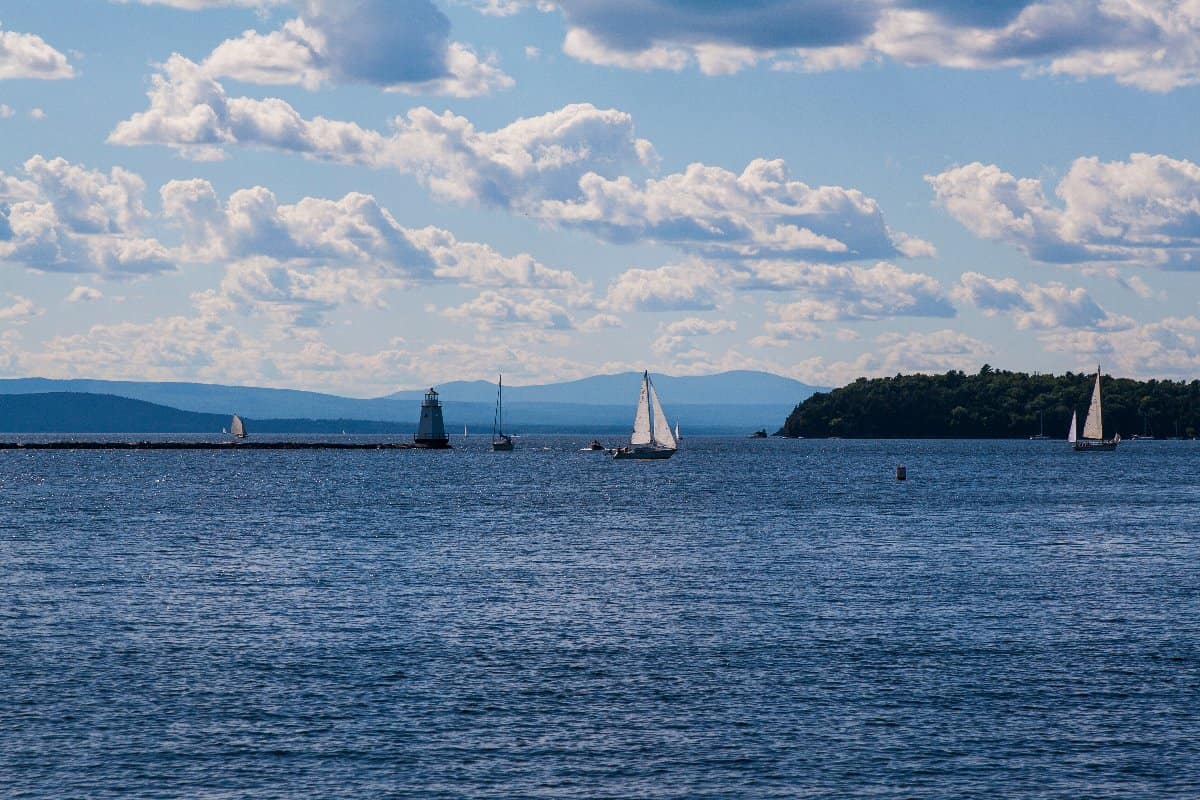Lake Champlain is a natural freshwater lake that lies between New York and Vermont. It also extends north into Quebec. Lake Champlain is 14.29 miles wide.
This article introduces wonderful details and fun facts to help you plan a visit to Lake Champlain. You will learn about its width and depth, and how visitors can take advantage of its beautiful shoreline and waters. We also cover how long it takes to swim across the entire lake! Let’s dive into the waters and discover Lake Champlain.
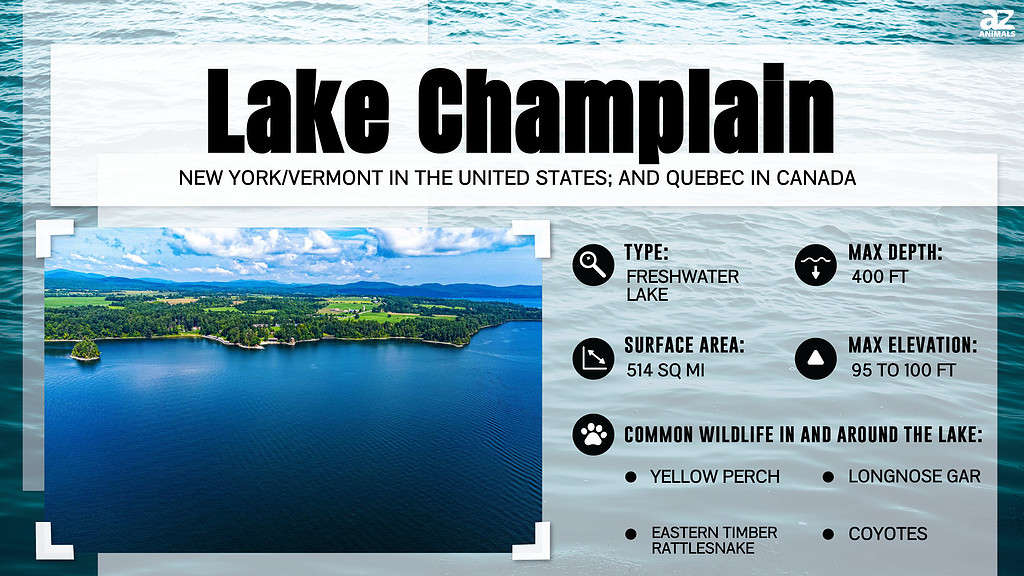
Width and Length of Lake Champlain
The lake is about 107 miles long and 14 miles at its widest point. Its surface area is estimated at 514 square miles and its average depth is 64, though the deepest point is 400 feet. Its location is between Essex, N.Y. and Charlotte, Vt. People swim the length of the lake, though it is difficult due to the temperature, waves, and wind.
However, Sara Thomas from Conifer, Colorado, took the challenge and upped the ante. The marathon swimmer swam non-stop for the entire 104 miles of the lake’s length in 2017. And she did it in 67 hours, breaking her own record. Her swim started on August 7, 2017, at Rouses Point, N.Y., the north end of the lake. The swimmer took a loop around Gardiner Island in Addison Country, Vermont, and ended back at her starting point on August 10, 2017.
The feat holds the world record for the longest continuous, unassisted, non-wetsuit swim in current-neutral conditions.
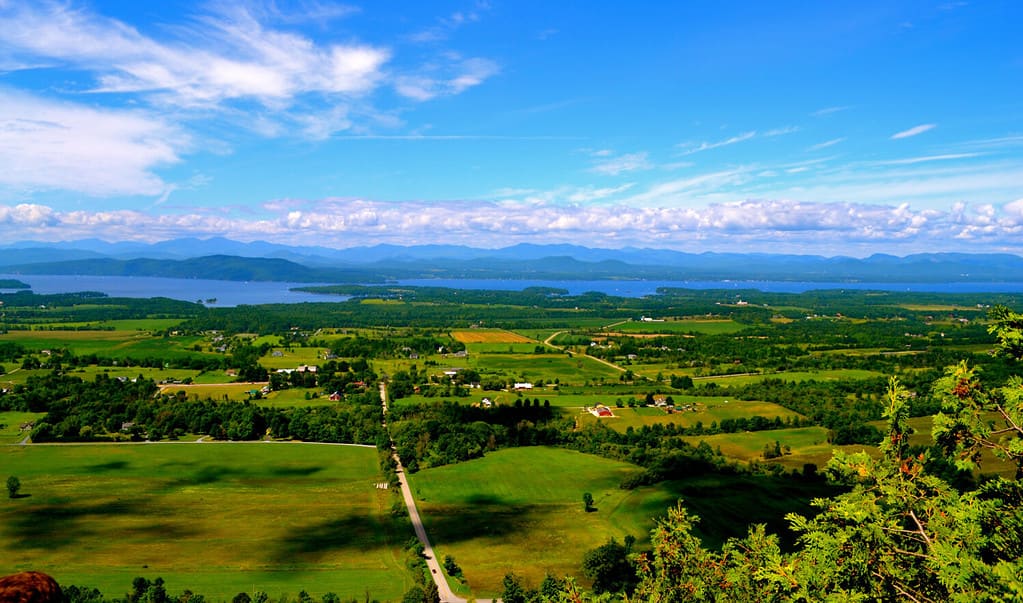
The lake’s temperature reaches an average of 70°F during the summer months of July and August.
©Monika Salvan/Shutterstock.com
History of Lake Champlain
Lake Champlain is a beautiful site to see. In fact, in 1998, it was even a Great Lake for 18 days. It was thought the lake could be the sixth Great Lake because of its connection to the St. Lawrence Seaway via the Richelieu River and the existence of the Champlain Canal.
However, the residents of Lake Champlain rescinded the bill that President Clinton signed. They believed the lake was unique and great enough to stand on its own. They weren’t wrong! The lake touches the United States and Canada, and thousands of people visiting New York, Vermont, and Quebec take the time to see the majestic 490 square miles of water nestled between the Adirondacks and the Green Mountains.
The biggest U.S. city on the lake’s shoreline is Burlington, Vt. This small but impressive town is a legend in Revolutionary War history, and the lake is a big part of that history. It allowed movement from the colonies to Canada. One could argue that it is the most significant historical body of freshwater in the United States. The lake has been a highway since Native Americans inhabited the land. It was a food source and a navigable travel route. Then, in the 1800s, its waters aided Americans to freedom by serving as the Champlain Line of the Underground Railroad.
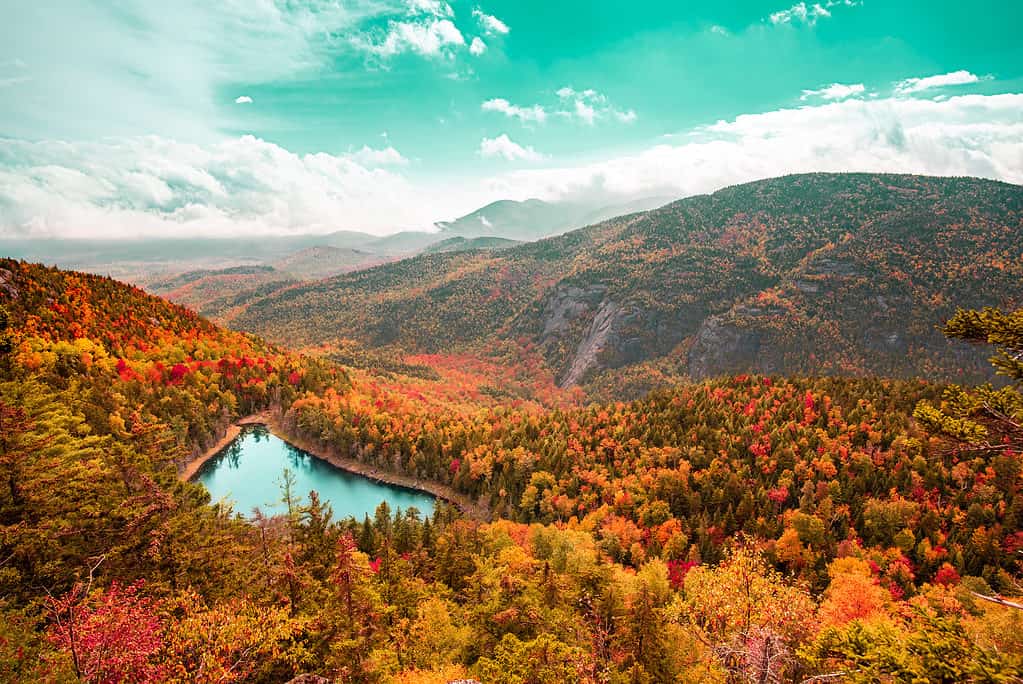
The lake spans the border between the Adirondacks and the Green Mountains.
©Mountain Man Photos/Shutterstock.com
Where is Lake Champlain?
Vermont lays claim to the majority of the lake, which lies in the northwest corner of the state as it spans over the New York border and flows westward to the Canadian border. The closest metropolitan area is Montreal, Quebec, which is just a one-hour drive from the lake. Boston is a three-and-a-half-hour drive, and New York City is five hours.
The lake is the Adirondacks’ lowest point in its entire six million acres. It is only 100 feet above sea level and the entire lake flows 125 miles north.
How Lake Champlain Compares to Other Lakes
Like the Great Lakes, Lake Champlain is a freshwater lake. However, it is about half the length of the shortest and smallest of the Great Lakes, Lake Ontario. By surface area, almost 17 Champlains would fit into Lake Ontario.
It is the 13th-largest freshwater lake in the United States by area.
| Lake | Size by Square Mile |
|---|---|
| Lake Superior | 31,700 sq mi |
| Lake Huron | 23,000 sq mi |
| Lake Michigan | 22,300 sq mi |
| Lake Erie | 9,910 sq mi |
| Lake Ontario | 7,340 sq m |
| Lake of the Woods | 1,679 sq mi |
| Iliamna Lake | 1,014 sq mi |
| Great Salt Lake | 950 sq mi |
| Lake Oahe | 685 sq mi |
| Lake Okeechobee | 662 sq mi |
| Lake Pontchartrain | 631 sq mi |
| Lake Sakakawea | 520 sq mi |
| Lake Champlain | 490 sq mi |
| Becharof Lake | 453 sq mi |
| Lake St. Claire | 440 sq mi |
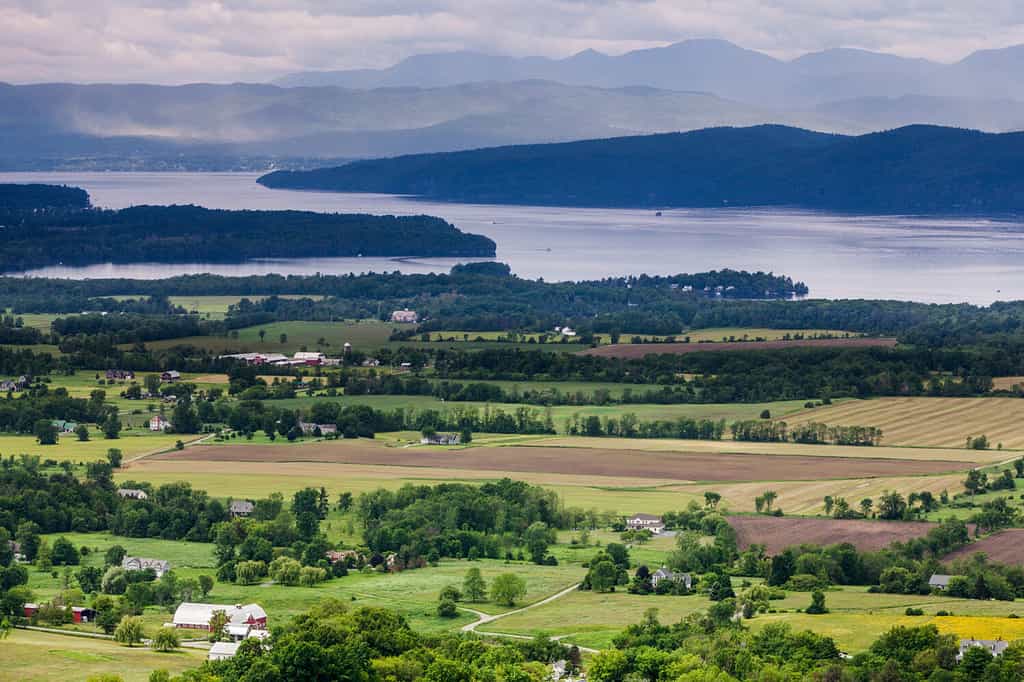
Lake Champlain forms a boundary between New York and Vermont for most of its length.
©Melanie Bishop/Shutterstock.com
Things to Do at the Lake
The lake’s waters are perfect for boating of all kinds! You can rent motorboats, paddleboats, or sailboats to view the gorgeous scenery of the towering mountains, rocky cliffs, and green fields. The lake also offers boat tours so you can put your feet up and admire the waterways, sandy shores, and surrounding nature.
Other activities include:
- Visit the Ornamental Farm at Shelbourne Farms
- Learn about American history at the North Star Underground Railroad Museum
- Book your accommodation on Knight Island
- Exercise on Burlington Bike Path
- Hike the trails at Waterfront Park
- Ferry from Burlington to Port Kent
- Shop at Church Street Marketplace
- Camp
How to Visit Lake Champlain
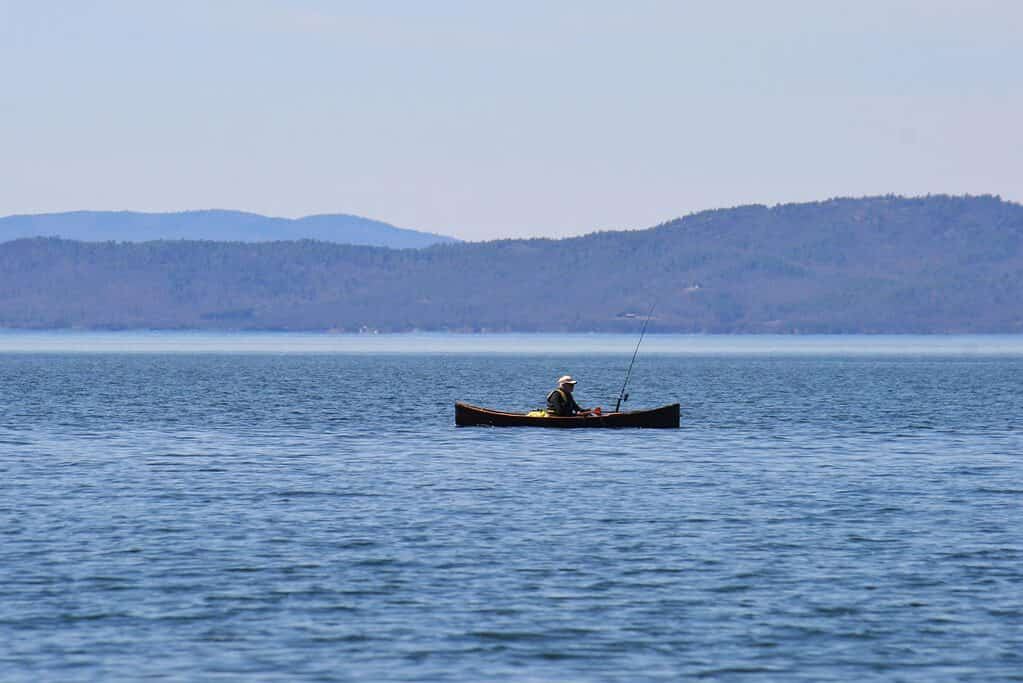
Vermont lays claim to most of this extraordinary lake.
©Ilir Hasa/Shutterstock.com
The shoreline of Lake Champlain travels into two states and even another country! There are 54 public beaches and hundreds of swimming holes along the 587 miles of shoreline for swimmers to take a dip! Visitors can swim, paddle, camp, picnic, fish, and soak up the sun in multiple regions. It is also a camper’s dream! A lot of the sites welcome day visits, if you’re eager to get back on the road. Lake Champlain accommodates all your traveling needs.
Here are some state parks and public beaches at the lake:
Vermont
State Parks
- Alburgh Dunes State Park, Alburgh – This is one of the lake’s largest beaches. It is a day-use park with hours from 10 a.m. to sunset. The beach is a natural sand south-facing beach. The name comes from the sand dunes that are at the center and western end. There is even a sand dune managed by the state to protect and restore any plants.
- Burton Island State Park, St. Albans – a 253-acre island with walking trails, campsites, and access via a passenger ferry
- Button Bay State Park, Ferrisburgh – Overnight and day use available
- D.A.R. State Park, Addison – This 95-acre state park is the ideal setting for anyone seeking an overnight visit or a relaxing day visit. It has a large, open campground and is ideal for birdwatching.
- Grand Isle State Park, Grand Isle – A full-facility park
- Kill Kare State Park, St. Albans – Popular recreational day-use area with swimming
- Kingsland Bay State Park, Ferrisburgh – Popular day-use area
- Knight Island State Park, North Hero – Primitive camping on a 185-acre island
- Knight Point State Park, North Hero – Day use area with swimming beach and boat rentals
- North Hero State Park, North Hero – Thick woods and old pasture with over 100 campsites
- Sand Bar State Park, Milton – Popular recreational day-use site with a sandy beach
- Woods Island State Park, St. Albans – Primitive camping on an island in the Inland Sea
Many of the state parks listed above have swimming areas as well. Some of the beaches may charge a fee for day use. Fees may vary for residents and non-residents of the municipalities that run the beaches.
Public Beaches
- Bayside Beach, Colchester
- Charlotte Town Beach, Charlotte
- Cohen Beach, St. Albans
- Ferrisburgh Town Beach, Ferrisburgh
- Leddy Beach, Burlington
- Maquam Beach, Swanton
- North Beach, Burlington – One of the larger beaches on the lake, and they have active lifeguards. The park and beach are open all year-round. Visitors can rent kayaks, canoes, and standup paddleboards.
- Oakledge/Blanchard Beach, Burlington
- Red Rocks Beach, South Burlington
- Shelburne Town Beach, Shelburne – The beach is day-use only, and open from sunrise to sunset. There are lifeguards on the beach from June to late August from noon to 6 p.m. However, when there is no lifeguard on duty, visitors may swim at their own risk.
- White’s Beach, South Hero
New York
State Parks
- Ausable Point Campground, Peru – Camping, hiking, and a natural sand beach
- Crown Point Campground, Crown Point – The 49-acre campground can also be a fun day visit for the family. Tourists can visit the ruins of the revolutionary era, Fort St. Frederic. The park is on the lower southwestern shore of Lake Champlain. This campground is rich with history as it sits over many battlegrounds, and even has the Crown Point Lighthouse on its property that is a memorial to the exploration of the lake by Samuel de Champlain.
- Cumberland Bay State Park, Plattsburgh – Day use, camping, and a natural sand beach
- Point Au Roche State Park, Beekmantown – Large day-use area, a protected sandy beach, picnic facilities, and concession stand
Public Beaches
- Ballard Park Town Beach, Westport
- Plattsburgh Beach, Plattsburgh – The park is a mile of sandy beach with a dedicated swimming area. There are also picnic tables, grills, a concession stand, kayak rentals, a natural trail, and restrooms with showers.
- Port Douglas Beach, Chesterfield
- Port Henry Beach, Port Henry
Safety Tips for Swimming in Lake Champlain
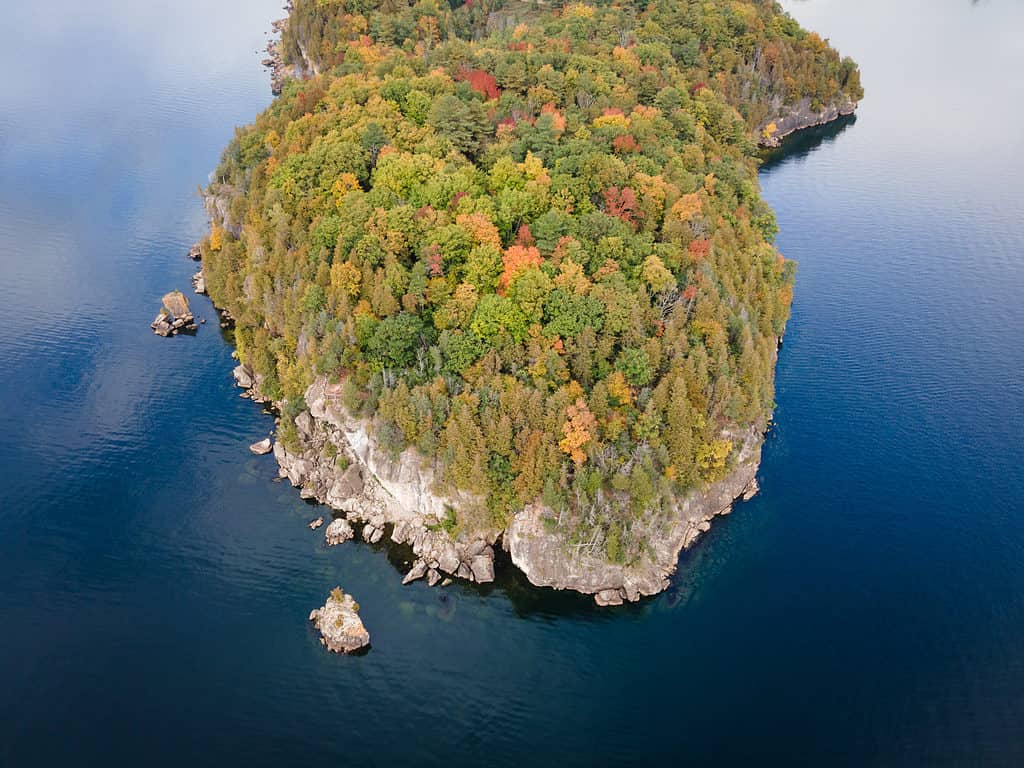
The fall colors at Lone Rock Point on Lake Champlain in Burlington, Vermont are extraordinary.
©iStock.com/Eifel Kreutz
When the water warms up, swimmers and boaters fill Lake Champlain. But danger can lurk in the waters if visitors aren’t prepared. Here are some tips to keep in mind when you get to the lake:
- Consider wearing water shoes while swimming. The bottom of the lake can be rocky and slippery.
- Heavy precipitation produces blue-green algae in the lake. According to the Department of Health, this can turn the water dark green, and algae blooms may also appear white, brown, red, or purple.
- Be aware of the lake’s temperature. The lake can easily be in the mid-40s to mid-50s. Cold shocks and sudden loss of body temperature are drowning hazards, so wear multiple layers or a wetsuit if the water is cold.
- Do research on the water you plan to dive into. It can be shallow, so jumping in can be dangerous. Also, some parts of the lake are very deep, so you want to be a strong swimmer and wear a life vest.
- Never swim alone.
- If in doubt, don’t go out.
Fun Facts About Lake Champlain
- The bottom of Lake Champlain is home to approximately 300 shipwrecks.
- The lake is a drinking water source for approximately 200,000 people.
- Lake Champlain is home to the oldest known fossil reef in the world.
- Champ is a mysterious creature, similar to the Loch Ness Monster, that many have claimed to see while enjoying the lake.
- Lake Champlain was named in 1609 by Samuel de Champlain, a French explorer.

Lake Champlain is rated the eighth naturally occurring body of freshwater in the United States.
©Cassie Blaise-Metcalf/Shutterstock.com
Thank you for reading! Have some feedback for us? Contact the AZ Animals editorial team.

